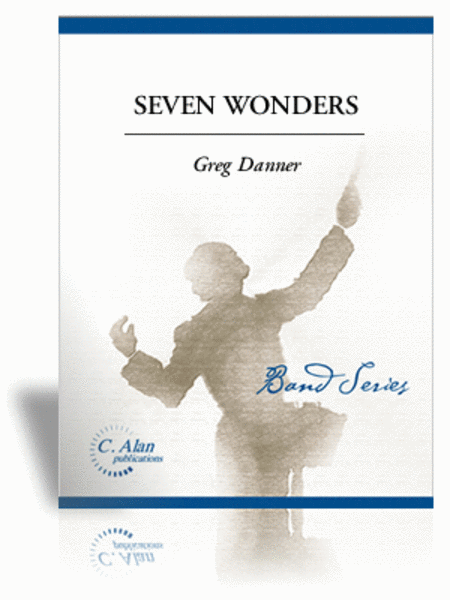Seven Wonders (score only)
-
Ships in 3 to 4 weeks
Details
Description
SKU: CN.18971
Composed by Greg Danner. Score only. Published by C. Alan Publications (CN.18971).The Seven Wonders of the World were monuments that expressed the culmination of man's ingenuity and imagination. They were architectural and engineering marvels, which inspire awe even today. The Great Pyramid of Egypt, the Hanging Gardens of Babylon, the Statue of Zeus at Olympia, the Temple of Artemis at Ephesus, the Mausoleum at Halicarnassus, the Colossus of Rhodes, and the Pharos lighthouse of Alexandria each have a fascinating story to tell. This suite for symphonic band is a musical reflection on the character and expression of these Seven Wonders.
The opening movement, Zeus at Olympia, begins with an introduction layering dissonant harmonies juxtaposed against simple diatonic figures and more complex chromatic lines, giving a primeval sense to the music. The material then moves into a declamatory section, developing short melodic and rhythmic motives that lead to a bold climax. The final measures return to the texture of the opening, with a sense of openness and mystery unresolved.
Artemis, the goddess of hunting and nature, was among the most worshipped deities of ancient Greece. The Temple of Artemis is an idyllic movement, beginning with a lyrical melody in the solo oboe that initiates the rhapsodic treatment of several melodic ideas.
The Pharos lighthouse at Alexandria, some 450 feet high, could be seen for over 30 miles at sea. This music takes an imagined scene of a ship at sea in a storm, searching for the light that will steer them to safety. The music begins with an anxiety that builds slowly, erupting in a clash of dissonance in the winds accompanied by the insistent beat of percussive forces. The music calms and moves into a prayer-like closing section—a salvation praising the Pharos.
The tomb of the Persian King Maussollos was the largest and most ornate tomb of the ancient world. The Mausoleum is a dirge, beginning with two 12-tone rows, the first stated by the low reeds and the second by the clarinets. This atonal music is briefly developed before being interrupted by a brass chorale of a more tonal character. The movement then develops both the 12-tone and the chorale texture throughout, ending quietly with fragments of the opening music.
Standing at the entrance to the island's harbor, the Colossus of Rhodes was an enormous bronze statue of the sun god Helios, serving to welcome travelers and to remind all of the power of this port city. Colossus begins with three solo trumpets pronouncing fanfare-like motives, and then develops this material throughout the ensemble. This music moves to a quicker, brilliant section featuring a bold brass melody in counterpoint to a bright woodwind ostinato. The movement reaches a peak with the return of the opening fanfare material stated in a glorious harmonic setting.
King Nebuchadnezzar of Babylon, as a gift, built the Hanging Gardens for his wife Amytis. Amytis was from the hill country of Medes and longed for the scenery of her home. According to legend, the gardens were terraces filled with dirt and planted with trees and flora, creating a lush paradise in the middle of the desert. This movement is a joyous dance, Middle Eastern in character, with light melodic figures and an animated rhythmic flow.
Standing as a tribute to mankind's achievement and the only surviving wonder is the Great Pyramid at Giza. Over two million blocks of stone, each weighing over two tons, comprise the monument, which remained the world's tallest structure for four millennia after it was built. The music begins by referencing the primeval music of the opening movement, with layers of sound alternating between diatonic and chromatic motives and figures. The sound masses subside to a new theme of a contemplative nature, presented in the solo horn and echoed by the solo oboe. Out of this, a simple ascending diatonic theme is stated, with variations that bring the movement to a glorious climax. A final, intense crescendo layering the sonic forces of the ensemble brings the work to a dramatic close.

 Share
Share